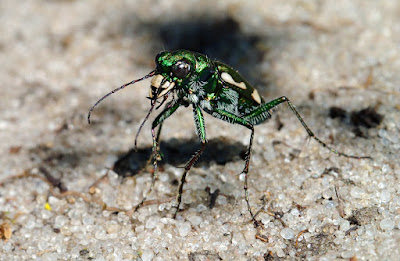"Rest is not idleness, and to lie sometimes on the grass under trees on a summer's day, listening to the murmur of the water, or watching the clouds float across the sky, is by no means a waste of time."
― John Lubbock
Did you get outside this past and final spring weekend? Friday, Saturday, and Sunday may go down as the nicest weather streak Wisconsin will have all year ― 70s and 80s sans intolerable humidity. Azure skies dominated until Sunday afternoon when clouds and haze began to move in. What to do with three days off? Maybe look for tiger beetles, eh?
But where? I'm not really planning to see all Wisconsin's tiger beetle species this year, but I have only photographed Northern Barrens Tiger Beetle on two previous occasions. The drive to Necedah National Wildlife Refuge isn't anything like going up to the Chequamegon, but it does have a boreal impression you don't find in southern part of the state. Even though there are only sixteen tiger beetle species in Wisconsin, for me they render endless challenges and enjoyment. There are more than 2,700 species throughout the world, and 116 in North America. At some point it might be fun to seek the likes of Whitish, Moustached, Beach, and many other tiger beetles outside of Wisconsin.
The Northern Barrens Tiger Beetle also has a long labrum similar to the Long-lipped ― longer than Splendid, Six-spotted, Bronzed, etc., but it doesn't look like a snout. My first specimen is the brown form, which was once thought to be a subspecies of C. patruela patruela called "huberi", but now considered a local color variant based on genetic studies.
I find the green form more aesthetically pleasing to my eye. They recall the Six-spotted Tiger Beetle, but the green is a little duller with larger and more defined maculations. You'll notice the sand in these photographs is lighter colored, which is a preference for Northern Barrens. Pearson states that this species is found in "dry sandy soils of mixed oak and pine forest usually in clearings of eroded sandstone and often associated with mosses, lichens, and ground-hugging vegetation", which is remarkably accurate for this particular location at Necedah NWR.
Adorable little monsters.
As documented on this blog previously, when tiger beetles begin to overheat, they'll seek shelter under the shade of plants. They'll cool down for a minute or two and then scoot back out to resume hunting. This back-and-forth behavior is called 'shuttling'. Sometimes when I'm crouched in position to photograph tiger beetles, they'll use my shade ― I can't photograph them when they do this, so I let them cool down and wait for them to resume hunting.
Sometimes accompanying Northern Barrens, here's a Six-spotted Tiger Beetle pair engaged in copulation. See the difference in their green color compared to the Northern Barrens? Do please note that the concealing stone was entirely incidental.
While searching for tiger beetles I came across this nifty Jumping Spider Phidippus whitmani. It was extraordinarily docile and made only short-distance moves while I photographed it for a few minutes. Eventually it moved into the grass so I moved on.
And lots of dragonflies were present at the boggy habitat ... Dot-tailed Whiteface and Frosted Whiteface. There were many other species, but they were a bit too quick chasing one another. I don't quite have the resilience and patience for frenetic flights of dragonflies and quickly lose interest.
Wildflowers along the bog ... Long-leaved Bluet and Blue-flag Iris ...
Alas, all fun nature outings must come to an end. On my way home I stopped at Sauk Prairie Recreational SNA to see if the Ghost Tiger Beetles had emerged, but nope. Next weekend! However, there were some opportunities to photograph grassland birds. On my way to the sandy field I drove past this singing Dickcissel. I was kind of in a hurry to check on the Ghosties, so I just kept going. On my way back out, though, I stopped to photograph him. Along the way out I found Clay-colored Sparrows, Henslow's Sparrows, Eastern Kingbirds, Brown Thrashers, and many other grassland specialists.
Only downside? 22 Wood Ticks!
All images © 2022 Mike McDowell





























